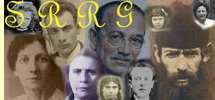1941
Three Gold Stars
When the United States entered WW II, after the Japanese attacked Pearl Harbor December 7, 1941, young men were drafted and families would display a cloth plaque with gold stars for each son or daughter serving in the military. They were sewn on a white satin cloth, bordered in red and blue which was hung in the front windows of patriotic families.
STANFORD--gold star number 1
The summer of 1940, Stanford, second-year student at Ohio State University was called to Washington DC for active duty in the Navy. He entered as a reservist, age 20.
|

|
Fortunately, Frankie's accute memory provides the details of these anxious years:
"Stanford spent two years at Ohio State, I think, before the Navy put him on active duty and sent him to Indianapolis for his early training. He went into the service with a friend, the son of the McKesson family, who owned a pharmaceutical firm on Ashland Avenue near Bancroft. This was about 1940. Stanford’s friend never came back. He was sent to the African Campaign and was killed there in November, 1940.
Stanford was sent to a facility near Washington, D.C. where he was trained for ninety days(that is why these Navy men were called ninety day wonders) in the Navy V-12 Program, which trained officers for the many ships that were being built in those days. After receiving his commission to Ensign, Stanford was sent to Boston.
(PICTURE # 1--Stan in white Ensign clothes)
I think he started out at the Harvard Electronics Laboratory and did some very basic research in the electronics field. There he met Lois Lenihan of Boston, Massachusetts and they went together for a while. Stan was transferred to the MIT Radiation Laboratory during that time, too. Lois was working at MIT, apparently, on what became known as the MIT Radiation Laboratory Series, a 30+ volume Technical set of books that was the bible of electronics and radar design of that era. Lois was the editor of volume 26 , "Feedback Amplifiers” that was a technical volume I used extensively in 1956, while I was working for Cornell Aeronautical Laboratory. Stan and Lois became engaged sometime around this period when we lived on 2415 Warren Street. Stanford had been promoted to Lieutenant (j.g. junior grade).
Stanford called home one morning at about 2:30 a.m. (August 1944). He said he was in California getting ready to ship out to the Pacific. He was the Communications Officer on the Heavy Cruiser, U.S.S. Santa Fe. The Santa Fe saw battle in the Pacific, ultimately towing the Aircraft Carrier Franklin back to the US through the Panama Canal. He had been promoted to (Lt. s.g. senior grade).
The Aircraft Carrier, USS Franklin's deck, was hit by a Japanese Kamikaze and was rendered inoperable. The Santa Fe, Stanford’s Ship, towed her into the New York Harbor via the Panama Canal. He wrote, in a letter we received shortly thereafter, that his ship had drifted within 60 miles of Tokyo. His ship performed a valiant effort to bring the Franklin under tow at a very critical time during the battle for Okinawa. Her steering mechanism was shot away and the Santa Fe drifted helplessly under the sea currents and wind, while towing her. (We don't know, but Stan probably received unit citations at least.)
I saw the ship in transit in the newsreel in the movies one day in 1945. After this ordeal, Stanford was discharged as a Lt. (s.g.), senior grade, and returned to MIT where he finished his undergraduate work and went on to graduate with a M./S.E.E., graduating fourth in his class."
|
After leaving the Service, Stan retired as a Lieutenant Commander.
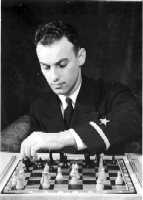
|
After the war, (Fall 1945), Stan visited us, bringing home his spanking white navy casual uniforms with neatly pressed large collars, trimmed in navy blue, that lay across the sailor's upper back. He also gave us his white, woolen blanket, that I thought was beautiful-- so soft and warm!
|
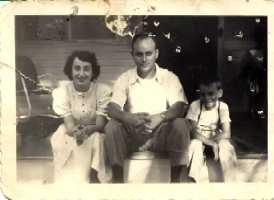
|
Frankie continues: "He (Stan) graduated in 1948 and was hired by North American Aviation in the Autonetics Division, which was developing Radar guidance systems for the first generation of Aircraft-Launched missiles, which I think was called the “Hound Dog.” Stanford obtained a patent, while there, for a “Doppler-Inertial” Navigation System, one of the first of its kind in the arsenal."
|
|
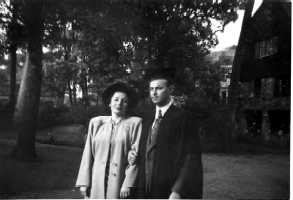
|
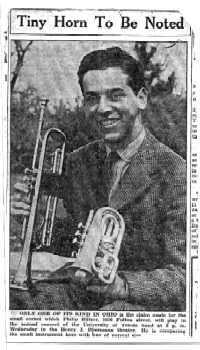
|
PHILIP--gold star number 2
September, 1940, Phil entered his last year at Scott High school. He was very active: president of the school orchestra **(first trumpeter), president of the Drama Club, Major Cheerleader…your basic "big man" on campus. The 1941 Spring Sports Program, about to be cancelled because of lack of funds, inspired the Drama Club to write an original Musical Revue. Profits from the tickets sales were donated to the sports program, which was reinstated.
The Musical was titled "Scott's A Popin" after the Olson and Johnson Broadway hit at the time called "Hell's A Popin". Phil wrote much of the show, composing two song and lyrics: "In My Little Bombproof Shelter" and "Rip Van Winkle". The Revue was a hit, ran for two nights, and thereafter became the annual Scott High show and fundraiser.
|
I was 9-10 years old, in the 4th grade who sang for the class (usually when the teacher was called out of the room….(probably to chat with a colleague!). I found the music for the two songs in the piano bench and sang them to my classmates. The students fell in love with "Rip Van Winkle" and throughout the War, I sang it many more times. At my 50th Scott High School Reunion, some of my friends began singing it, they knew the lyrics so well.
Phil graduated Scott High June of 1941, age 18. To pay his way through Toledo University, he worked the midnight shift at the Willys Overland Factory. He was assigned to the Combustion Department. The factory was manufacturing shells for 500 lb bombs as part of the "Lend Lease" program the US government had contracted with England already at war with Germany. Phil's job involved testing the running water temperature (by hand) that cooled the shells during production. Phil had bought a car for about $125. to drive to TU during the day and work nights at Willys. He did this during the summer-fall of 1941, and winter of 1942. By the summer of 1942, after Pearl Harbor was attacked and the USA was at war with Japan, Phil and Helen's husband, Will Fingerhut, decided to join the Army rather than wait to be drafted. It was the 100th Division which Phil says was sent to Normandy. Phil and Will began their training in Centerville, Missippi. Will spent his Army years there because of a medical disability.
|

|
Phil had taken tests to join the Army Air Corps; more than anything he wanted to pilot an airplane. After serving in the Army for about six months, Phil heard his sargeant shout one day, "hey Blitzer", you passed the Air Corps tests!
Phil's training took him to Nashville, Tennesee and Montgomery, Alabama (Maxwell Airfield) where Monday, June 28th, 1943 he finished preliminary training. Phil went on to Avon Park, Clearwater, Florida where he was taught "solo flying" and after nine solo hours, he was tested and "washed out", having failed one signal. He was sent to Miami, Florida for 2-3 months (played the trumpet in the Army Air Corps band and was given the option to continue performing with the band for the duration of the war) or train as an ECM operator (Electronics Counter Measures) and "waist gunner" on a B-24 Liberator Bomber. Phil read Morse Code, intercepted radar, and when under attack, became a gunner.
Phil chose active duty and for about the next year traveled around the country (Yuma, Arizona, Sioux Falls, South Dakota (Lena managed to visit Phil then). My brother Chuck recalls finding a small white phonograph record in the house with Lena's voice, who was interviewed along with other families visiting their son/daughter in the military.
Finally, by the end of 1943, Phil was sent to Charleston, South Carolina for his last phase which consisted of the crew mastering flight formation, dropping bombs, etc. Completing this training, Phil and his fellow crew members were sent to Westover, Massachusetts where they joined other air corps crews preparing for overseas duty.
The route from Westover, Massachusetts to their destination, Bari, Italy on the Adriatic sea, (due south of Vienna), included flights to, (but not necessarily in this order) air fields in Gander, Newfoundland; the Azore Islands, mid-Atlantic Ocean; Merrakech, Morocco, N. Africa; Tunis, Tunisia, N. Africa; Dakar, Senegal and probably others. The crew flew missions over various targets including the Balkans, Northern Italy, and Germany. The flyers received 1 point for each mission with a goal of 50 points, at which time their war duty would be completed and the men could return home. "2 points" for more dangerous targets such as Munich, Germany and others were offered as motivation, so Phil flew 23 more missions to achieve this goal, thus receiving credit for having flown 50.
SIDNEY--"secret" gold star
The Ethyl Corp in Baton Rouge, Lousiana turned its research at this time to the War Effort.
Sid, a scientist at the company since 1938, was given a deferment because of its urgent government work.
At this time, Sidney became Lena and Adolph's "power of attorney", which enabled him to receive government notices regarding Stan and Phil.
On Phil's second mission, the plane was struck, requiring the crew to bail out. Already in a diving spin, the plane was about to hit Phil. Fortunately, by manipulating the parachutte, he was able to free himself clear and landed in a ditch in Belgrade, Yougoslavia. Close by German soldiers practiced their maneuvers. Phil lay there for some time (one ankle hurt from the fall) and eventually was spotted by a Tito Partisan on horseback, who picked up Phil and took him to his home.
Sidney received a "missing-in-action" notice from the government, but kept the news from my parents and the family. Phil spent about three weeks at the Partisan's home, (the US government paying the Partisans $500. for every American soldier saved), and was sent to the "Isle of Capri, Italy" to rest for a month before continuing missions. I still have a beautiful small, handkerchief that Phil sent to me from there, embroidered with the message "To my Darling Sister". Phil flew 48 more missions, received the purple heart, a Silver Star with oak leaf clusters, and the Air Medal, and was sent home, having flown a total of 50 missions.
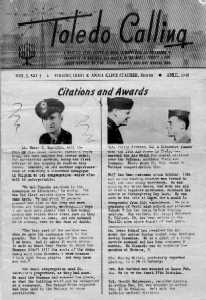
|
"Master Sgt. Philip Blitzer, 22, a Liberator gunner with the 15th Air Force in Italy was award the Air Medal for combat mission over the Balkans, Northern Italy and Germany. Photo shows Lt. Col. James C. Watkins congratulating him.
Phil has been overseas since October, 1944 and on one bombing mission was forced to bail out over enemy territory. He was missing for three weeks, but with the aid of Tito's Yugoslav partisans, rejoined his outfit on Thanksgiving Day last. (November 1944) He was sent to the Isle of Capri for a month to recuperate from this experience. He is a graduate of Scott High school and attended Toledo U for two years before donning uniform.
His brother, Lt. (s.g.senior grade) Stanford D. Blitzer, 24, has been active in the Pacific area since August of last year, (1944)."(4)
|
|
|

